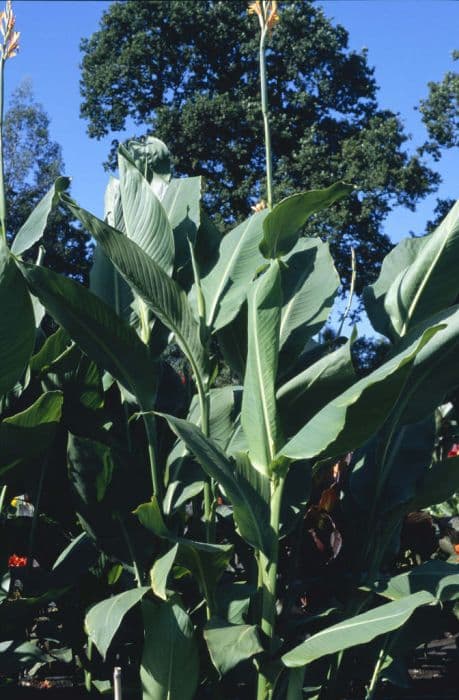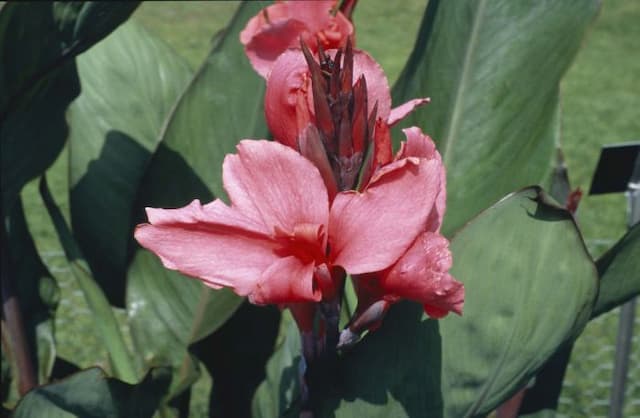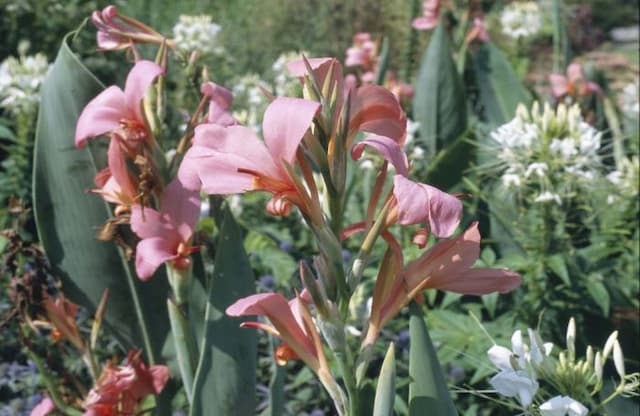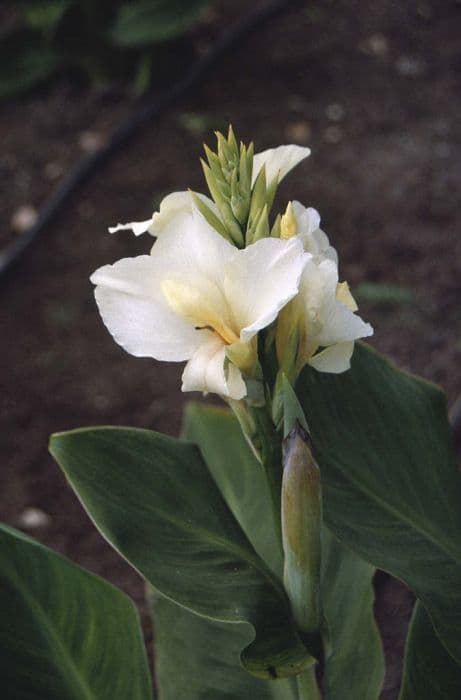Indian shot Canna indica

ABOUT
Canna indica, commonly known as Indian Shot, is a vibrant and tropical herbaceous perennial plant. Its striking appearance is characterized by large, banana-like leaves that unfurl in a lush green hue, often with a hint of blue-gray, bronze, or maroon. These broad leaves are oblong in shape and can have smooth or undulated edges, providing a substantial backdrop to the brilliant flowers. The Indian Shot's flowers are its most remarkable feature, boasting an array of fiery colors like red, orange, yellow, or even a combination of hues, which are set against the verdant leaves. The blossoms are asymmetrical and resemble the shape of a gladiolus, consisting of petals that are both showy and waxy, arranged in a spike-like formation. Adding to its exotic charm, the Indian Shot grows in clumps that contribute to a full and lush presentation, making it an eye-catching addition to gardens. The plant also produces round, black seeds that are hard and resemble shotgun pellets, a characteristic that inspired the name "Indian Shot." These seeds are housed in pods that form after the flowers are spent. Overall, the Indian Shot exudes a tropical flair with its striking foliage and vivid flowers, making it a popular choice for gardeners seeking to add a splash of color and drama to their landscape.
About this plant
 Names
NamesFamily
Cannaceae.
Synonyms
Indian Shot, African Arrowroot, Edible Canna, Sierra Leone Arrowroot, Canna Lily, Bandera, Chancle, Coyol, Capacho.
Common names
Canna achiras, Canna amabilis, Canna ascendens, Canna aurantiaca, Canna bidentata, Canna bifida, Canna brasiliensis, Canna chinensis, Canna cinnabarina, Canna coccinea, Canna compacta, Canna crocea, Canna dasyphylla, Canna densifolia, Canna discolor, Canna edulis, Canna ellipticifolia, Canna esculenta, Canna exigua, Canna flaccida, Canna flavescens, Canna floribunda, Canna formosa, Canna heliconiifolia, Canna humilis, Canna indica var. orientalis, Canna juncea, Canna lagunensis, Canna lanuginosa, Canna lauterbachii, Canna liliiflora, Canna limbata, Canna lutea, Canna macrophylla, Canna maxima, Canna montana, Canna nepalensis, Canna patens, Canna pentaphylla, Canna platyphylla, Canna plurituberosa, Canna poeppigii, Canna polyclada, Canna polymorpha, Canna portoricensis, Canna proctoriana, Canna pruinosa, Canna pulchra, Canna roscoeana, Canna rubra, Canna sanguinea, Canna saturate-rubra, Canna schubertii, Canna sellowii, Canna speciosa, Canna sulphurea, Canna tetragona, Canna textoria, Canna thyrsiflora, Canna tinei, Canna variegatifolia, Canna variegata, Canna velutina, Canna ventricosa, Canna warszewiczii, Canna x generalis.
 Toxicity
ToxicityTo humans
Canna indica, commonly known as Indian shot, is generally not considered poisonous to humans. There is no widespread evidence of toxicity or adverse health effects from ingesting parts of this plant. However, as with many plants, individual reactions such as allergies could still occur, so it is advisable to avoid consuming it unless it is known to be safe.
To pets
Indian shot is not commonly listed as a toxic plant for pets such as dogs and cats. It is generally considered non-toxic, and there is limited information regarding its adverse effects if ingested by pets. Nevertheless, pet owners should always monitor their animals for any unusual reactions after ingestion of any plant material, as individual sensitivities can vary. If any symptoms do arise, it is best to consult a veterinarian.
 Characteristics
CharacteristicsLife cycle
Perennials
Foliage type
Deciduous
Color of leaves
Varies
Flower color
Varies
Height
3-4 feet (0.9-1.2 meters)
Spread
1-2 feet (0.3-0.6 meters)
Plant type
Herb
Hardiness zones
8-11
Native area
South America
Benefits
 General Benefits
General Benefits- Ornamental Value: Canna indica, commonly known as Indian shot, has attractive foliage and brightly colored flowers that enhance the aesthetic appeal of gardens and landscapes.
- Low Maintenance: Indian shot is easy to grow and requires minimal care, making it a suitable choice for novice gardeners and those with busy lifestyles.
- Drought Tolerance: The plant is quite resilient to dry conditions, which makes it suitable for xeriscaping and for gardens in arid climates.
- Soil Adaptability: Indian shot can thrive in a variety of soil types, which makes it versatile for planting in different garden settings.
- Pollinator Attraction: The vibrant flowers of Indian shot attract pollinators such as bees, butterflies, and hummingbirds, promoting biodiversity.
- Erosion Control: The root system of Indian shot helps stabilize soil, making it beneficial for preventing erosion in certain areas.
- Flood Tolerance: Indian shot can also withstand occasional flooding, which can be advantageous in rain gardens or in areas with fluctuating water levels.
- Fast Growth: Indian shot grows relatively quickly, which can be ideal for gardeners looking to establish a garden or fill in spaces rapidly.
 Medical Properties
Medical Properties- Antioxidant: Canna indica has been reported to possess antioxidant properties due to its phenolic and flavonoid content.
- Anti-inflammatory: The plant's extracts are sometimes used for their potential anti-inflammatory effects.
- Antibacterial: Some studies suggest that Canna indica may have antibacterial activity against certain strains of bacteria.
- Analgesic: There are indications that extracts from the plant could have analgesic or pain-relieving effects.
- Antipyretic: Canna indica may help reduce fever, although clinical evidence is limited.
 Air-purifying Qualities
Air-purifying QualitiesThis plant is not specifically known for air purifying qualities.
 Other Uses
Other Uses- Canna indica, commonly known as Indian Shot, has seeds that can be used as beads in jewelry due to their hard texture and attractive appearance.
- The starchy rhizomes of Indian Shot can be processed to produce a biodegradable plastic alternative, contributing to sustainable material development.
- The leaves of Indian Shot are sometimes used as plates or wrappers for food in some cultures, utilizing their large and pliable nature.
- Indian Shot fibers can be extracted and used in the creation of paper, offering an eco-friendly source of paper pulp.
- When dried, the sturdy stocks of Indian Shot can serve as burnable biomass for fuel, helping in energy production.
- The vibrant flowers of Indian Shot can be used as natural dyes, offering a range of colors for textiles and crafts.
- As a component in the bioremediation process, Indian Shot can be utilized to cleanse contaminated water bodies, absorbing and breaking down pollutants.
- Indian Shot can be interplanted amongst crops as a pest deterrent, leveraging its potential to repel certain agricultural pests.
- In some regions, Indian Shot leaves are used for roofing material due to their size and water-resistant properties.
- The rhizomes of Indian Shot can be fermented and transformed into a mild alcoholic beverage in some traditional practices.
Interesting Facts
 Feng Shui
Feng ShuiThe Indian Shot is not used in Feng Shui practice.
 Zodiac Sign Compitability
Zodiac Sign CompitabilityThe Indian Shot is not used in astrology practice.
 Plant Symbolism
Plant Symbolism- Beauty: With its vibrant colors, Canna indica is often associated with beauty and splendor.
- Strength: The plant’s sturdy stalk represents resilience and strength.
- Change and Transition: As Canna indica goes through a life cycle of growth, bloom, and dormancy, it symbolizes change and the ability to adapt.
- Prosperity and Wealth: Due to its full, lush growth, it is sometimes seen as a symbol of prosperity and abundance.
- Creation and Creativity: The plant's bold colors and striking appearance can represent creativity and the spark of new ideas.
 Water
WaterCanna Lilies should be watered to keep the soil consistently moist but not soggy. During the growing season, water them thoroughly once a week with about 1-2 inches of water. In hotter, drier periods, you may need to water Canna Lilies twice a week. Always water at the base of the plant to avoid wetting the foliage, as this could promote fungal diseases. The exact amount of water may vary depending on your local climate, but generally, an average of about 0.5 to 1 gallon per week should suffice.
 Light
LightCanna Lilies prefer full sun to partial shade. They thrive in bright, direct sunlight for at least 4-6 hours a day. The best spot for these plants is in an area where they receive morning sun and some afternoon shade, especially in hotter climates. Avoid deep shade, as it can lead to poor flowering and weak growth.
 Temperature
TemperatureCanna Lilies are tropical plants and enjoy warm temperatures between 60°F and 90°F. They can tolerate a minimum temperature of 50°F but will stop growing if temperatures drop significantly below this point. Ideal conditions for these plants are warm days and mild nights, so they're perfect for summer gardens.
 Pruning
PruningPruning Canna Lilies involves removing old flowers and seed pods to encourage new growth and more blooms. Prune in late winter or early spring before new growth starts. Deadheading, or removing spent flowers, can be done throughout the growing season to maintain a tidy appearance. Pruning is not strictly necessary but can help the plant look its best.
 Cleaning
CleaningAs needed
 Soil
SoilIndian Shot requires a nutrient-rich, well-draining soil mix with a pH between 6.0 and 6.5. A good recipe is to mix equal parts of loamy garden soil, peat, and perlite or sand to ensure proper drainage and fertility.
 Repotting
RepottingIndian Shot should be repotted every 2 to 3 years to replenish nutrients and accommodate its growth. Best done in spring before the growing season starts.
 Humidity & Misting
Humidity & MistingIndian Shot thrives in moderate to high humidity levels, ideally between 60-70%, but it can tolerate lower humidity if necessary.
 Suitable locations
Suitable locationsIndoor
Place Indian Shot in a bright spot and keep soil moist.
Outdoor
Full sun, rich soil, water well, fertilize monthly.
Hardiness zone
8-11 USDA
 Life cycle
Life cycleCanna indica, commonly known as Indian shot, begins its life cycle as a dormant rhizome which sprouts in spring as temperatures warm. The rhizome sends up shoots that develop into large, paddle-shaped leaves, establishing a strong foliage presence. Throughout the summer, the plant produces tall flower stalks with brightly colored flowers that may be red, orange, or yellow, attracting pollinators. After pollination, the flowers develop into round, black seeds that resemble shotgun pellets, hence the common name Indian shot. In regions with a cold season, the plant dies back to the rhizome in autumn, which overwinters until the following spring to start the cycle anew. In tropical climates, where Canna indica may not experience a dormant period, the plant can continue to grow and bloom throughout the year, with rhizomes occasionally spreading to form larger clumps or colonies.
 Propogation
PropogationPropogation time
Spring to Summer
Canna lilies, commonly known as Canna indica, are most popularly propagated by dividing their rhizomes. The best time for dividing and planting canna lilies is in the spring after the last frost has passed and the soil has warmed up to at least 50 degrees Fahrenheit (about 10 degrees Celsius). This allows the plant to establish itself during the warmer growing season. To propagate, carefully dig up the rhizomes with a shovel, ensuring that each division has at least one eye, which is a growth point for new shoots. Rhizomes should be cut using a sharp knife, and any damaged or diseased sections should be removed. The divisions can then be planted about 3 to 4 inches (7.5 to 10 centimeters) deep in well-draining soil, spacing them about 1 to 2 feet apart (30 to 60 centimeters) to give them enough room to grow. Water the newly planted rhizomes thoroughly to settle the soil around them and provide consistent moisture until new growth appears.









